

Overview
It is the Ravenna institution that has collected the city's manuscript and printed heritage. Having liquidated the religious orders and their patrimony in 1798 by Napoleon, the Classense became the civic library a few years later, taking its name from the library of the Camaldolese monks that had been brought here from the abbey of Classe, but also taking over the library collections of the other major cenobia. Among the most important collections were and are codices, incunabula, valuable printed editions, autographs, music manuscripts, correspondence, drawings, woodcuts, copperplates and lithographs.
Special funds acquired later include that of the 18th-century architect Camillo Morigia, the builder of Dante's Tomb, and the Raccolta Dantesca assembled by the bibliophile-publisher Leo Olschki, the most comprehensive collection of rare editions focusing on Dante's work.
Another interesting Dantesque initiative one encounters while walking around the city is Camminare Ravenna con la Divina Commedia (Walking Ravenna with the Divine Comedy), a project of the local Lions Clubs. One hundred plaques were affixed in the streets, not necessarily all in places specifically linked to the memory of Dante, each dedicated to a canto of the Divine Comedy. Each plaque has a QR-code, through which one can view the text of the canto, listen to it recited and find it framed in Dante's cosmology, as well as have its summary and a simplified summary available